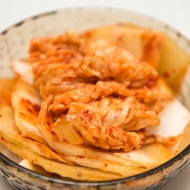
Kimchi (Spicy Korean Cabbage Snack)
⏳ Time
2 hours
🥕 Ingredients
13
🍽️ Servings
12
Description
You can find the recipe for the basic kimchi seasoning in my recipes, or simply search for Basic Kimchi Seasoning. The optimal flavor of kimchi develops in about a week and retains its original taste for approximately 3 weeks. After 4 weeks, kimchi usually starts to sour quickly (this type of kimchi is for those who enjoy it), and it can be used for cooking hot dishes. For the basic seasoning recipe 'Yangnyeom', refer to my cookbook. This amount is just enough for the specified amount of cabbage.
Ingredients
- Water - 10 fl oz
- Napa Cabbage - 6 lbs
- Onion - 1 head
- Asian Pear - 1 piece
- Minced garlic - 6 tablespoons
- Grated Ginger Root - 1 tablespoon
- Salt - 2 tablespoons
- Sugar - 1 tablespoon
- Fish Oil - 3 fl oz
- Daikon - 10.6 oz
- Scallions - 2 bunches
- Glutinous Rice Flour - 3 tablespoons
- Bulgogi Sauce - 1 cup
Step by Step guide
Step 1
Rinse the cabbage lightly, cut it in half lengthwise, and remove the cores. Then immerse it in water to ensure that water gets between the leaves; this is necessary for the salt to distribute evenly in the cabbage. Next, take coarse salt and distribute it evenly between the leaves. Tear off 3–4 large leaves of cabbage and salt them as well. We will need them later. Place the cabbage halves in a container, cover with water so they are completely submerged, and weigh them down. Leave to brine for about 6–8 hours. After about 3 hours, turn the cabbage (swap the bottom halves with the top ones).
Step 2
Once the cabbage is brined, rinse it well under running water, gently squeeze it out, and place it in a colander for 30 minutes.
Step 3
After washing the cabbage, tear off a large leaf (from the middle of the half) and taste it for salt. Naturally, the meatier part of the leaf will be less salty than the tip. This will help us determine how well the cabbage has been salted and how much salt to add to the seasoning for a balanced salt level.
Step 4
Now let's prepare the seasoning. First, make the rice paste (starch). Dissolve two tablespoons of rice flour (chapssal garu) in 150 ml of cold water, bring the remaining water to a boil, and add the dissolved flour. Mix well to avoid lumps. The result should be a paste, similar to that used for wallpapering — traditionally, this paste is made from one tablespoon of high-starch rice (chap ssal) and two cups of water, then cooked until it becomes a thick paste. This is quite a lengthy process, so it's better to make this paste in the simpler way described above.
Step 5
Cut the radish and pear into strips about 2.5 by 2.5 mm, slice the green onion into 5 cm lengths, and slice the onion into very thin half-rings. Lightly salt the radish; the juice released can be drained later.
Step 6
Chop the garlic and ginger (you can use a meat grinder), add the basic seasoning, fish sauce, sugar, and the paste. Mix well.
Step 7
Add the resulting mixture to the chopped vegetables and mix. Let it sit for about 30 minutes. Then taste the mixture for salt and remember how much salt is in the cabbage; add salt if necessary.
Step 8
Put on rubber gloves, and generously coat each cabbage leaf with the mixture, then tightly fold the leaves back into the half head, take the longest leaf, and carefully wrap it around and place it in a container. Once everything is packed, take the leaves we prepared earlier and cover the top.
Step 9
Leave the container at room temperature for a day (juice should be released), then place it in the refrigerator for about three days. Before serving, cut the kimchi into pieces about 2.5 cm long.
Cooked This Dish? Share Your Delicious Creation with the Community! 🥰
Snap a photo and let everyone see your culinary masterpiece. Inspire others and showcase your skills!
Users Photos
No photos yet
Leave a Comment
Please log in to leave a comment.